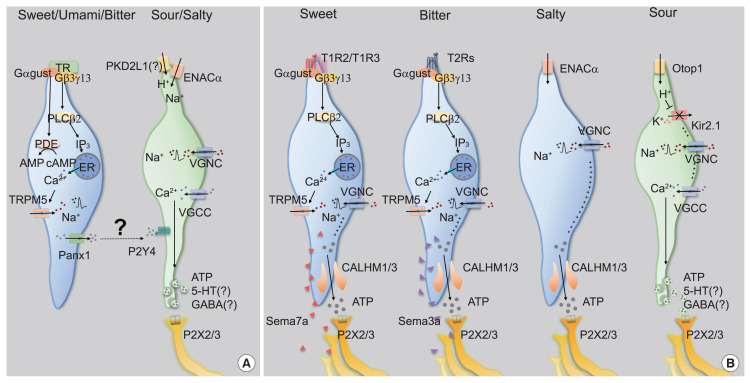Fig. 2.
Comparison of past and current understanding of taste transduction in type II and type III taste cells. (A) Past proposed model. Type II taste cells transmit sweet, umami, or bitter taste signals to afferent nerve fibers in a type III taste cell-dependent manner, while type III taste cells transmit either salt or sour taste signals to afferent nerve fibers. (B) Current proposed model. Type II taste cells, salt cells, and type III taste cells individually transmit taste signals of sweet or bitter, salt, and sour tastes, respectively, to the afferent nerve fibers paired with each taste cell. Type II taste cells detect sweet, umami, or bitter taste by G-protein coupled receptors (GPCRs) that act in pairs (T1R2+T1R3 for sweet, and T1R1+T1R3 for umami) or act alone (T2Rs for bitter). GPCR-mediated signal transduction elevates the cytoplasmic Ca2+ concentration by releasing Ca2+ from the intracellular stores. Elevation of cytoplasmic Ca2+ in turn activates transient receptor potential cation channel subfamily m member 5 (TRPM5), depolarizes the cell to generate action potentials through voltage-gated sodium channel (VGNC), and releases adenosine triphosphate (ATP) through calcium homeostasis modulator 1/3 (CALHM1/3). Semaphorin 7A (SEMA7A) secreted by sweet taste receptor cells (TRCs) and SEMA3A secreted by bitter TRCs guide sweet and bitter ganglion neurons to the sweet and the bitter TRCs, respectively. Sodium cells are depolarized by the influx of Na+ through amiloride-sensitive epithelial sodium channel alpha subunit (ENACα). Action potentials are generated by an additional Na+ influx through voltage-gated sodium channel (VGNA) activation, independently of the intracellular Ca2+ signaling pathway, eventually releasing ATP through CALHM1/3. Type III taste cells detect sour taste by H+ influx through Otop1 channels. Intracellular acidification inhibits Kir2.1, and sequentially activates VGNA and voltage-gated calcium channel (VGCC), leading to neurotransmitter (NT) release using synaptic vesicles. Gαgust, Gα-gustducin; PDE, phosphodiesterase; PLCβ2, phospholipase Cβ2; IP3, inositol trisphosphate; DAG, diacylglycerol; Panx1, pannexin-1; PKD2L1, polycystin 2 like 1; 5-HT, 5-hydroxytryptamine; GABA, γ-aminobutyric acid; P2X2, P2X purinoceptor 2; P2X3, P2X purinoceptor 3; ER, endoplasmic reticulum; Otop1, otopetrin-1; Kir2.1, inward rectifier K+ channel.

